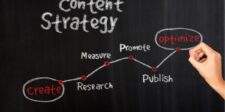Publishing an article is just the start of your content marketing journey, but ensuring it reaches the right audience is what drives success. In fact, studies show that businesses who prioritize blog promotion see 13 times more ROI than those who don’t. This makes article promotion a crucial element of content strategy, not just an afterthought.
In this guide, we’ll cover practical steps to promote your article—from SEO and social sharing to influencer outreach and tracking tools. Each tactic is built to increase visibility, extend reach, and turn your content into a long-term traffic driver.
Why Promoting Your Blog is Important
Promoting your blog is essential because it directly influences its visibility and reach. Without promotion, even the most well-crafted articles can remain hidden, missing out on potential traffic and engagement.
In fact, according to recent data, blogs that are actively promoted receive up to 55% more traffic than those that aren’t. Effective promotion helps build brand awareness, drive targeted traffic, and improve SEO performance, ultimately leading to higher conversions and long-term success.
Effective Article Promotion: Core Steps to Drive Engagement
Promoting an article is essential to maximize its reach and ensure it delivers results. By following these core steps, I can strategically increase visibility, boost engagement, and drive long-term value from my content.
1. Optimize the Article for SEO
A business owner begins by ensuring the article is optimized to rank in search engines before it ever goes live.
This includes identifying relevant keywords their audience is searching for, integrating them naturally into the title, subheadings, and body, and writing a compelling meta description.
Proper optimization increases the chance of long-term organic traffic without relying on paid ads.
They also make sure the article follows technical best practices like fast page speed, mobile responsiveness, and internal linking to other relevant pages. These factors help search engines crawl the site efficiently and improve the user’s experience.
Over time, well-optimized content contributes to higher visibility, better click-through rates, and sustained traffic.
To keep the article optimized and visible, the owner follows this routine:
- The article is fully optimized before publishing and re-evaluated every 3–6 months for relevance and search performance.
- Weekly checks using tools like Google Search Console help catch indexing errors, ranking drops, or broken links early.
2. Leverage Social Media Platforms
Once published, the article is immediately distributed across the business’s most active social media channels. Each platform receives customized content—different headlines, visuals, or captions—to match the behavior and tone of that audience.
This increases the chances of engagement and drives qualified users back to the article.
The business owner treats social promotion as an ongoing cycle, not a one-time action. By rotating formats and experimenting with post timing, they extend the lifespan of a single article.
Social platforms also provide instant feedback on what messaging resonates, allowing for fast iteration.
Here’s how they time and manage their social distribution:
- They publish the first round of posts within 24 hours and re-share the article weekly using fresh copy throughout the first month.
- Post engagement is reviewed after 48 hours to identify which platform deserves follow-up attention or paid amplification.
3. Use Email Marketing
The article is shared directly with subscribers through the company’s email list, which is often the most engaged and loyal audience.
The email contains a short, benefit-driven message and a clear call to action that leads to the full article. This method consistently drives higher click-through rates than generic platform posts.
To improve results, the owner segments their list based on interest or activity, sending the article only to the readers most likely to care. Personalization increases engagement and builds stronger relationships over time.
Unlike social media algorithms, email ensures the article lands directly in the reader’s inbox.
The owner follows this promotional email schedule:
- They send the first article email within 1–2 days of publishing while attention is fresh.
- The article is later included in a monthly digest or re-shared during relevant seasonal or topical campaigns.
Need to write social captions, email blasts, or outreach messages for your article promotions? Let HelperX Bot draft it all in seconds—tailored to your audience and voice.
4. Collaborate with Influencers and Bloggers
To expand reach beyond their existing network, the business owner partners with influencers or respected bloggers in the same industry. They pitch relevant content collaborations, such as guest posts, backlink exchanges, or expert quotes linking back to the article.
When done right, these partnerships expose the article to an already-engaged audience and build trust through third-party credibility.
They carefully choose collaborators whose voice and audience align with their brand values. The goal isn’t just traffic—it’s the right kind of traffic from people likely to convert or engage further.
Over time, these strategic relationships compound, opening doors to more organic sharing and visibility.
They follow this collaboration workflow to stay consistent:
- Outreach begins 1 week before the article goes live if collaborators will be part of the initial launch.
- Follow-ups are sent within 7–10 days post-publication to secure shares, backlinks, or mentions in newsletters and social posts.
5. Engage with the Audience
Once the article is live, the business owner actively monitors audience interaction across channels. They respond to blog comments, reply to social media mentions, and acknowledge reader feedback to build trust and encourage repeat engagement.
This two-way communication helps the brand feel more accessible and authentic.
They also use engagement to gather valuable insights for future content. Questions, compliments, or criticisms can highlight what resonated—and what didn’t. Maintaining this dialogue improves brand loyalty and increases the chances that readers will share the article with others.
To maintain momentum after publishing, they follow this engagement rhythm:
- They check for and respond to comments within 24–48 hours after sharing the article.
- They revisit each promotion channel bi-weekly to re-engage or answer late interactions.
6. Use Paid Promotion
When immediate reach is the goal, the business owner uses paid ads to promote the article to targeted audiences. Platforms like Facebook, LinkedIn, and Google Ads allow precise segmentation based on interests, behavior, or job roles.
This helps drive traffic from users who are most likely to benefit from the article’s content.
They treat paid promotion as a testing ground, using small budgets to evaluate headline performance, audience targeting, and ad visuals. Once a winning version is identified, the budget is scaled to maximize results. This approach ensures money is spent where it delivers the highest return.
Their paid promotion workflow looks like this:
- They launch ad campaigns within 72 hours of publishing and run initial tests for 5–7 days.
- Ad performance is reviewed every 2–3 days to optimize copy, audience segments, or budget allocation.
7. Submit to Content Aggregators
The business owner expands their article’s reach by submitting it to content aggregators like Medium, Reddit, or Quora. These platforms attract niche audiences who are actively browsing for new information, making them ideal for surfacing useful content.
When submitted properly, the article can spark valuable discussions and generate organic traffic.
They carefully select relevant communities and follow platform rules to avoid coming off as self-promotional. On forums like Reddit, they contribute genuinely to discussions before sharing links. This boosts credibility and increases the chances that their article gets read and shared.
To align with audience activity, they follow this posting schedule:
- They submit the article within 1–3 days of publishing to align with initial visibility efforts.
- They revisit active threads or community channels monthly to re-engage and contribute fresh insights.
8. Track and Adjust Performance
After the article is live, the business owner uses analytics tools to monitor how it performs across channels. They track page views, average time on page, bounce rates, and referral sources to evaluate which tactics worked best.
This data guides their decisions for current promotions and future campaigns.
They also compare different distribution channels side-by-side to see where engagement is highest. Underperforming platforms or posts are either improved or retired. Over time, this habit of adjustment leads to better resource allocation and stronger content ROI.
They manage performance monitoring with this simple cadence:
- Metrics are reviewed weekly for the first month to catch early performance patterns.
- A full 30-day traffic and conversion report is used to adjust future promotion strategy.
9. Repurpose the Content Across Multiple Channels
To extend the article’s visibility and lifespan, the business owner repurposes it into other content formats. They turn sections into LinkedIn carousels, quotes into tweet threads, or key stats into infographics for Instagram and Pinterest.
This helps them reach audiences who prefer visual or audio content over long-form reading.
They make sure each format suits the channel it’s being published on, preserving clarity and relevance. Repurposing also saves time, since the core message is already created and just needs reshaping. It’s one of the most efficient ways to multiply reach without starting from scratch.
They follow this repurposing rollout to maintain content momentum:
- High-performing articles are repurposed within the first 2 weeks after initial publication.
- Additional formats are released gradually over 30–45 days to maintain visibility across platforms.
10. Encourage User-Generated Content
To build organic reach and trust, the business owner encourages readers and followers to share their own reactions or related insights. They prompt discussion by asking questions, requesting feedback, or inviting responses to the article’s message.
This transforms readers into contributors, increasing the content’s reach without extra ad spend.
Select user-generated responses appear in future posts or newsletters to recognize engagement and inspire further participation. This strategy strengthens community ties and increases article credibility through peer validation. The more people interact, the farther the article spreads.
Here’s the recurring UGC schedule they follow:
- Social posts and emails in the first week include clear prompts to spark user engagement.
- Every 4–6 weeks, the team launches new UGC rounds or “feature spotlights” to maintain ongoing participation.
Best Tools to Track Article Rankings and Performance
Tracking how an article performs is essential for improving reach, refining promotion tactics, and identifying what actually works. These tools help business owners monitor rankings, engagement, and traffic so they can make data-backed decisions.
Google Analytics
Google Analytics is a free and widely trusted tool that shows how users interact with your article in real time. It tracks metrics like pageviews, bounce rate, traffic sources, and time on page. These insights help identify which promotion channels are effective and where users drop off.
Google Search Console
Google Search Console lets you monitor how your article performs in Google search results. It shows impressions, clicks, average position, and search terms that led users to your content. This tool is crucial for spotting indexing issues and optimizing for better keyword visibility.
Ahrefs
Ahrefs is a powerful SEO tool that provides detailed tracking of keyword rankings, backlinks, and organic traffic. You can see how your article ranks for target keywords over time and what websites are linking to it. It also offers content gap insights, helping you adjust or expand based on competitor data.
SEMrush
SEMrush tracks your article’s keyword positions, visibility score, and SERP features across search engines. It offers deep analytics on content performance and helps identify which articles bring the most organic traffic. The Position Tracking feature is especially useful for watching how your article moves in the rankings.
Hotjar
Hotjar gives visual insight into how readers behave on your article page through heatmaps, scroll tracking, and session recordings. It helps you understand what parts of your article users actually engage with versus what they ignore. These insights are valuable for improving layout, structure, or CTAs.
Final Thoughts on Promoting an Article Effectively
Promoting an article isn’t a one-time task—it’s a structured process that involves SEO, distribution, engagement, and ongoing refinement. When business owners treat content like an asset and follow a consistent promotion plan, they extend its reach, improve performance, and maximize long-term value.
From leveraging email and influencers to tracking data with the right tools, every step adds momentum.
Success comes from execution, not guesswork. By repurposing content, encouraging interaction, and analyzing what resonates, owners can stretch a single article across multiple channels and cycles.
With the right tools and timing in place, promotion becomes a repeatable engine—not a shot in the dark.
Turn every article into a marketing asset. Use HelperX Bot to plan distribution, repurpose content, and write campaign-ready messages that multiply reach with less effort.
Frequently Asked Questions
Most articles benefit from active promotion for at least 30 days after publishing. Continued efforts like repurposing, re-sharing, and optimizing can keep it relevant for months, especially if the content is evergreen or regularly updated.
Tuesdays and Wednesdays often see higher engagement for B2B content, while weekends may perform better for lifestyle and consumer-facing articles. Timing should be adjusted based on audience behavior and platform-specific analytics to maximize reach.
Yes, updating older articles with fresh data, improved structure, or new visuals makes them more promotable. Search engines favor updated content, and a refreshed version gives readers more value, increasing the chances of re-engagement and shares.
Source:
- https://www.demandsage.com/business-blogging-statistics/
- https://www.redsearch.com.au/resources/blogging-statistics/

We empower people to succeed through information and essential services. Do you need help with something? Contact Us.
Want a heads-up once a week whenever a new article drops?







